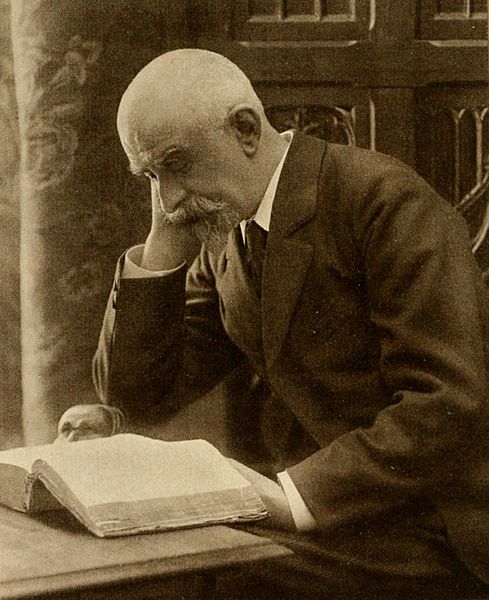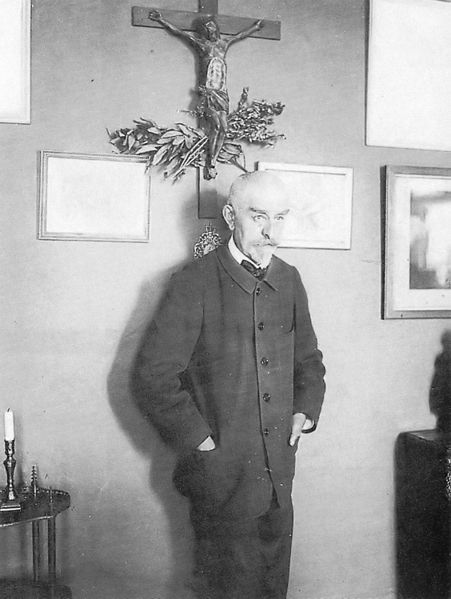<Back to Index>
- Physicist Robert Hofstadter, 1915
- Novelist Charles Marie Georges Huysmans, 1848
- Prime Minister of France Pierre Eugène Jean Pflimlin, 1907
PAGE SPONSOR


Charles-Marie-Georges Huysmans (February 5, 1848 – May 12, 1907) was a French novelist who published his works as Joris-Karl Huysmans; he is most famous for the novel À rebours (Against the Grain or Against Nature). His style is remarkable for its idiosyncratic use of the French language, wide ranging vocabulary, wealth of detailed and sensuous description, and biting, satirical wit. The novels are also noteworthy for their encyclopaedic documentation, ranging from the catalogue of decadent Latin authors in À rebours to the discussion of the iconography of Christian architecture in La cathédrale. Huysmans' work expresses a disgust with modern life and a deep pessimism, which led the author first to the philosophy of Arthur Schopenhauer then to the teachings of the Catholic Church.
He was born in Paris to a Dutch father,
Godfried Huysmans, who was a lithographer by trade. His mother, Malvina
Badin, had been a schoolmistress. He published his works as "Joris-Karl
Huysmans", using an approximation of the Dutch equivalent of his forenames, to emphasize his roots. Huysmans' father died when he was eight years
old, and his mother quickly remarried, leaving Huysmans feeling a great
deal of resentment against his stepfather, Jules Og, a Protestant who
was part owner of a Parisian book-bindery. Huysmans' school years were unhappy but he obtained a baccalauréat.
For thirty-two years, he worked as a civil servant for the French
Ministry of the Interior, a job he found insufferably tedious. The
young Huysmans was called up to fight in the Franco - Prussian War, but was invalided out with dysentery, an experience he described in his early story Sac au dos (Backpack) (later included in Les Soirées de Médan). His first major publication was a collection of prose poems, heavily influenced by Baudelaire, called Le drageoir aux épices (1874). They attracted little attention but already revealed flashes of the
author's distinctive style. Huysmans followed it with Marthe, Histoire d'une fille (1876). The story of a young prostitute, it was much closer to Naturalism and brought him to the attention of Emile Zola.
His next works were in a similar vein: sombre, realistic and filled
with minutely detailed evocations of Paris, the city Huysmans knew
intimately. Les Soeurs Vatard, dedicated to Zola, deals with the lives of women in a book bindery. En ménage is
an account of a writer's failed marriage (Huysmans himself never
married, but had a long term lover called Anna Meunier). The climax of
this early period is the novella À vau-l'eau (Downstream or With the Flow), the story of a downtrodden clerk, Monsieur Folantin, and his futile quest for a decent meal. This was followed by Huysmans' most famous novel À rebours (Against the Grain or Against Natureor Wrong Way) (1884), which featured a single character, the aesthete des Esseintes, and decisively broke from Naturalism, becoming the ultimate example of "decadent" literature. des Esseintes' explicit homosexual encounters influenced other writers of the decadent movement, including Oscar Wilde, and is considered an important step in the formation of "gay literature". À rebours gained
further notoriety as an exhibit during the trials of Oscar Wilde in
1895, during which the prosecutor referred to the novel as a "sodomitical"
book. The book also appalled Zola, who felt it had dealt a "terrible
blow" to Naturalism. Huysmans began to drift away from the Naturalists and found new friends among the Symbolist and Catholic writers whose work he had praised in À rebours, including Jules Barbey d'Aurevilly, Villiers de L'Isle Adam and Léon Bloy. Stéphane Mallarmé was
so pleased with the publicity his verse had received from the novel
that he dedicated one of his most famous (and most obscure) poems, Prose pour des Esseintes to its hero. Barbey d'Aurevilly told Huysmans that after writing À rebours he
would have to choose between "the muzzle of a pistol and the foot of
the Cross", and Huysmans, who had received a secular education and
abandoned his religion in childhood, did indeed return to the Catholic
Church eight years later. Huysmans' next novel, En rade,
a highly unromantic account of a summer spent in the country, was
relatively unsuccessful commercially. In 1891, the publication of Là-Bas attracted considerable attention for its depiction of Satanism in
late 1880s France. The book introduced the character Durtal, a thinly
disguised portrait of the author. The later Durtal novels, En route (1895), La cathédrale (1898) and L'oblat (1903), trace Durtal/Huysmans' conversion to Roman Catholicism. En route depicts Durtal's spiritual struggle during his stay at a Trappist monastery. La cathédrale finds the protagonist at Chartres, making an intense study of the cathedral and its symbolism. In L'Oblat, Durtal becomes a Benedictine oblate, finally reaching an acceptance of the suffering in the world. Huysmans was also known for his art criticism: L'Art moderne (1883) and Certains (1889). He was an early advocate of Impressionism, as well as an admirer of such artists as Gustave Moreau and Odilon Redon. He was a founding member of the Académie Goncourt. Huysmans was made a Chevalier de la Légion d'honneur in
1892, but only for his work with the civil service. In 1905, his
admirers persuaded the French government to promote him to Officier de
la Légion d'honneur in view of his literary achievements. In the
same year, Huysmans, a cigarette smoker, was diagnosed with cancer of
the mouth. Joris-Karl Huysmans died in 1907 and was interred in the Cimetière de Montparnasse, Paris. Barbaric
in its profusion, violent in its emphasis, wearying in its splendor, it
is - especially in regard to things seen - extraordinarily expressive,
with all the shades of a painter's palette. Elaborately and
deliberately perverse, it is in its very perversity that Huysmans' work
- so fascinating, so repellent, so instinctively artificial - comes to
represent, as the work of no other writer can be said to do, the main
tendencies, the chief results, of the Decadent movement in literature. (Arthur Symons, "The Decadent Movement in Literature") ...Continually dragging Mother Image by the hair or the feet down the worm eaten staircase of terrified Syntax. (Léon Bloy, quoted in Robert Baldick, The Life of J.-K. Huysmans) It
is difficult to find a writer whose vocabulary is so extensive, so
constantly surprising, so sharp and yet so exquisitely gamey in
flavour, so constantly lucky in its chance finds and in its very
inventiveness. (Julien Gracq)